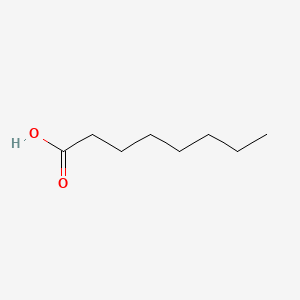octanoic acid
octanoic acid is a lipid of Fatty Acyls (FA) class. Octanoic acid is associated with abnormalities such as Ischemia, Diabetes Mellitus, Non-Insulin-Dependent, Diabetes, Cardiomyopathies and Obesity. The involved functions are known as Anabolism, 5-(carboxyamino)imidazole ribonucleotide mutase activity, Citric Acid Cycle, Metabolic Inhibition and Excretory function. Octanoic acid often locates in Pore, Protoplasm, Endothelium, Mitochondria and Muscle. The associated genes with octanoic acid are P4HTM gene, CPT1A gene, HADH gene, ACSL1 Gene and CD36 gene. The related lipids are Fatty Acids, Nonesterified Fatty Acids, Oleates, Palmitates and hexanoic acid.
References related to abnormalities published in Others
| PMID | Journal | Published Date | Author | Title |
|---|---|---|---|---|
| 9725814 | Am. J. Physiol. | 1998 | Bonen A et al. | Palmitate transport and fatty acid transporters in red and white muscles. |
| 9655697 | Am. J. Physiol. | 1998 | Maes BD et al. | Gastric emptying flow curves separated from carbon-labeled octanoic acid breath test results. |
| 22648712 | Am. J. Clin. Nutr. | 2012 | Yamamoto Y et al. | Rapid alternative absorption of dietary long-chain fatty acids with upregulation of intestinal glycosylated CD36 in liver cirrhosis. |
| 21876211 | Dis Model Mech | 2012 | Chang P et al. | The antiepileptic drug valproic acid and other medium-chain fatty acids acutely reduce phosphoinositide levels independently of inositol in Dictyostelium. |
| 20876709 | Diabetes Care | 2010 | Tesfaye S et al. | Diabetic neuropathies: update on definitions, diagnostic criteria, estimation of severity, and treatments. |
| 19074983 | Diabetes | 2009 | Padmalayam I et al. | Lipoic acid synthase (LASY): a novel role in inflammation, mitochondrial function, and insulin resistance. |
| 15550523 | Am. J. Physiol. Heart Circ. Physiol. | 2005 | Labarthe F et al. | Fatty acid oxidation and its impact on response of spontaneously hypertensive rat hearts to an adrenergic stress: benefits of a medium-chain fatty acid. |
| 25326131 | J. Pharmacol. Exp. Ther. | 2015 | Chang P et al. | Seizure control by derivatives of medium chain fatty acids associated with the ketogenic diet show novel branching-point structure for enhanced potency. |
